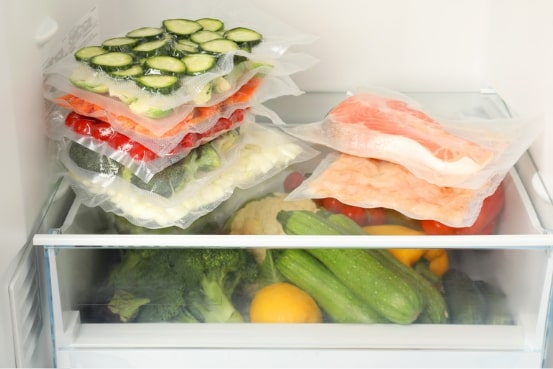Vacuum packaging is a highly effective preservation technique used to prolong the shelf life of perishable items, particularly food. This method involves removing the air from the packaging, which in turn slows down the oxidation process and inhibits the growth of bacteria, mold, and yeast.
Utilizing the full potential of vacuum packaging is essential for both culinary professionals and individuals looking to maximize freshness, save money, and reduce food waste. This preservation method acts as a highly effective solution to extend the lifespan of food products. Proper preservation ensures that products stay fresh and retain their delightful flavors for an extended period.
Advantages of Vacuum Packing
Increased Shelf Life
Category Advertising, Media Consulting, Marketing Research reports that vacuum packing has the potential to extend a product's shelf life by more than 50% of the typical duration. The key to achieving this lies in determining the optimal packaging environment for the specific product, which may involve adding inert gas or carefully controlling oxygen levels.
The vacuum packaging method is highly favored for products intended for long-term freezer storage. It offers significant reduction in freezer burn when suitable vacuum bags are used. This method is widely employed for the preservation of meat and is well-regarded in the industry.
Reduced Product Loss
Vacuum packing provides a substantial edge over other packaging techniques for lowering product loss. An airtight container is sealed with a vacuum to protect a product from contamination and degradation. This is especially important for delicate items to oxygen, moisture, or other airborne pollutants.
Vacuum packaging can help increase a product's shelf life by keeping it fresher. Vacuum-packed products are also less likely to be misplaced or suffer issues due to transportation damage.
Sealed Barrier From External Elements
The most commonly used thickness for vacuum bags is three mils, although certain bags used for vacuum-packaged dried fruit can have a thickness ranging from 6 to 8 mils. When properly sealed, vacuum packaging provides a protective barrier against external contaminants such as dust, moisture, insects, and other potential irritants. It serves as an excellent defense against freezer burn when storing food in the freezer for an extended period.
Seals in Flavors
A standard method of curing meat before cooking is wet aging. This frequently employs vacuum-sealed natural juices from the meat, spices, and seasonings to preserve flavours throughout the curing process.
No Chemical Preservatives Required
There is no need for chemical preservatives with vacuum packaging. Products can last longer without using commonly used preservatives with the correct oxygen-to-inert gas ratio. The most popular inert gas for this item is nitrogen, about 78% of the earth's atmosphere.
Improved Product Presentation
The transparency of most vacuum bags allows the contents to be displayed on shelves, providing visibility to customers. By utilizing custom printed stickers, vacuum packaging enables products to be shelf-ready, such as vacuum-packaged dried tomatoes.
Multiple Packaging Options
There are various packaging methods for vacuum-sealing products, offering customers different options. These methods include using rolls of film or pre-made bags for sealing purposes. Bags come with a variety of features such as reclosable zippers, easy-open tear notches, foil lining, channelling, and more. This wide range of features provides customers with flexibility and convenience when choosing their preferred vacuum-sealing solution.
Quick and Efficient Packaging
Vacuum packaging is one of the fastest and most effective packaging techniques. Vacuum sealing can be very effective, allowing hundreds or thousands of objects to be sealed every hour with the right tools and materials.
Tips for Vacuum Packing
Vacuum packing is highly beneficial for storing food and other items as it helps conserve space while ensuring the freshness of your belongings. To make the most of vacuum packing, consider the following essential tips:
Make Use of the Proper Type of Bag
To prolong the freshness of food, it is important to use appropriate vacuum sealing bags that are specifically designed for this purpose. Using the right type of bag ensures a strong seal and prevents food from spoiling.
Avoid using bags that are not intended for vacuum sealing, as they may result in a weaker seal and potential food spoilage.
Make Sure You Add the Appropriate Amount of Food
Don't stuff the bag too firmly; give it room to breathe so it can be secured tightly. Using a vacuum sealer to store food necessitates more space in the bag. If you don't, ensure the machine can do its work and that the bag is packed appropriately. If the bag tears, remember to leave the extra room while packing your food or luggage.
Double-Check the Bag’s Seal
To ensure optimal performance and longevity of your vacuum sealer, there are important steps to follow:
- Verify that the bag is properly filled before vacuuming.
- Ensure that the bag is completely sealed before placing it in the vacuum sealer.
- Avoid leaving any air trapped inside the bag to prevent strain and potential damage to the vacuum sealer.
- Prioritize efficient air removal by properly filling the bag.
- Double-check the seal of the bag to ensure it is airtight.
Maximize the effectiveness and longevity of your vacuum sealer by following these steps.
Maintain the Appropriate Degree of Vacuuming Intensity
Avoid vacuuming too vigorously or damaging the item or food you are cleaning. The appropriate amount of vacuum pressure must be used to ensure your food products are adequately sealed and no air is trapped within the bag.
If you apply insufficient pressure, your food may not be adequately sealed. In addition, delicate items might be harmed by excessive force, and the vacuum sealer itself may be shattered. The right amount of vacuum pressure to use while sealing food depends on the type of food you're sealing.

